Engineering Management Report: ERP System Analysis and Security
VerifiedAdded on 2020/04/07
|18
|4823
|71
Report
AI Summary
This report provides a comprehensive analysis of Enterprise Resource Planning (ERP) systems, examining their features, components, and security aspects within a business context. It begins with an executive summary and introduction, outlining the problem of traditional information management and the need for ERP to enhance security and productivity. The report explores the aim and objectives of implementing an ERP system, followed by a brief methodology. A literature review highlights key studies on ERP selection, implementation, and change management. The core of the report details the features, components, and tools used in ERP systems, emphasizing client-server architecture, application software, and various modules. It then focuses on security in ERP systems, discussing security policies, user authentication, and authorization. The importance and outcomes of ERP systems for companies are analyzed, along with an evaluation for implementing ERP on business, and concluding with references.

ENGINEERING MANAGEMENT
Paraphrase This Document
Need a fresh take? Get an instant paraphrase of this document with our AI Paraphraser
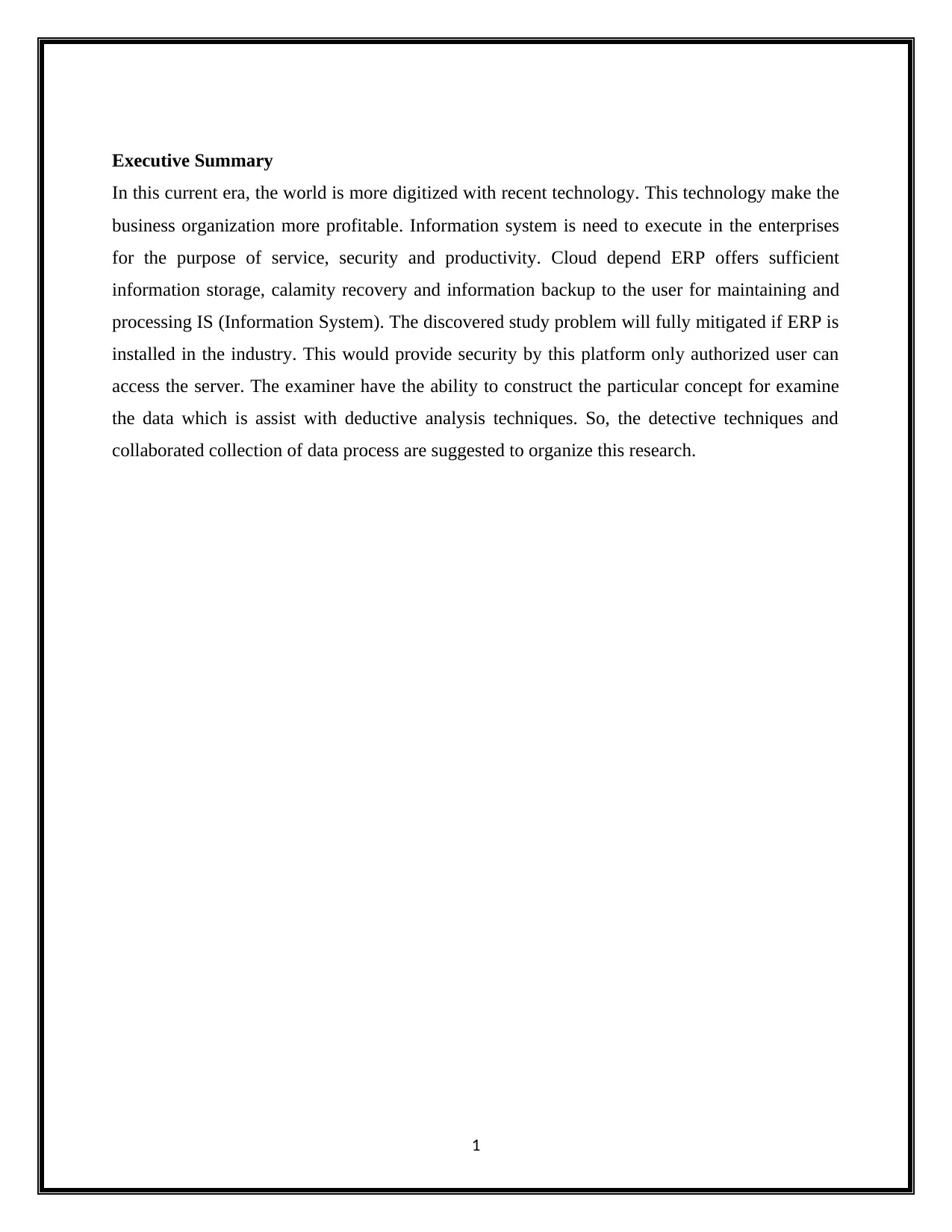
Executive Summary
In this current era, the world is more digitized with recent technology. This technology make the
business organization more profitable. Information system is need to execute in the enterprises
for the purpose of service, security and productivity. Cloud depend ERP offers sufficient
information storage, calamity recovery and information backup to the user for maintaining and
processing IS (Information System). The discovered study problem will fully mitigated if ERP is
installed in the industry. This would provide security by this platform only authorized user can
access the server. The examiner have the ability to construct the particular concept for examine
the data which is assist with deductive analysis techniques. So, the detective techniques and
collaborated collection of data process are suggested to organize this research.
1
In this current era, the world is more digitized with recent technology. This technology make the
business organization more profitable. Information system is need to execute in the enterprises
for the purpose of service, security and productivity. Cloud depend ERP offers sufficient
information storage, calamity recovery and information backup to the user for maintaining and
processing IS (Information System). The discovered study problem will fully mitigated if ERP is
installed in the industry. This would provide security by this platform only authorized user can
access the server. The examiner have the ability to construct the particular concept for examine
the data which is assist with deductive analysis techniques. So, the detective techniques and
collaborated collection of data process are suggested to organize this research.
1

Table of Contents
Executive Summary.........................................................................................................................1
1. Introduction..............................................................................................................................2
1.1 Brief statement of the problem..........................................................................................3
1.2 Research aim and objectives.............................................................................................3
1.3 Brief methodology............................................................................................................4
2. Literature review......................................................................................................................4
3. Features of ERP........................................................................................................................6
4. Components and tools used in ERP.........................................................................................6
5. Security in Enterprise Resource Planning System...................................................................7
6. The importance and outcomes of ERP systems for companies’..............................................9
7. Analyze and Evaluation for Implementing ERP on Business................................................11
8. Conclusion..............................................................................................................................13
9. References..............................................................................................................................14
2
Executive Summary.........................................................................................................................1
1. Introduction..............................................................................................................................2
1.1 Brief statement of the problem..........................................................................................3
1.2 Research aim and objectives.............................................................................................3
1.3 Brief methodology............................................................................................................4
2. Literature review......................................................................................................................4
3. Features of ERP........................................................................................................................6
4. Components and tools used in ERP.........................................................................................6
5. Security in Enterprise Resource Planning System...................................................................7
6. The importance and outcomes of ERP systems for companies’..............................................9
7. Analyze and Evaluation for Implementing ERP on Business................................................11
8. Conclusion..............................................................................................................................13
9. References..............................................................................................................................14
2
⊘ This is a preview!⊘
Do you want full access?
Subscribe today to unlock all pages.

Trusted by 1+ million students worldwide
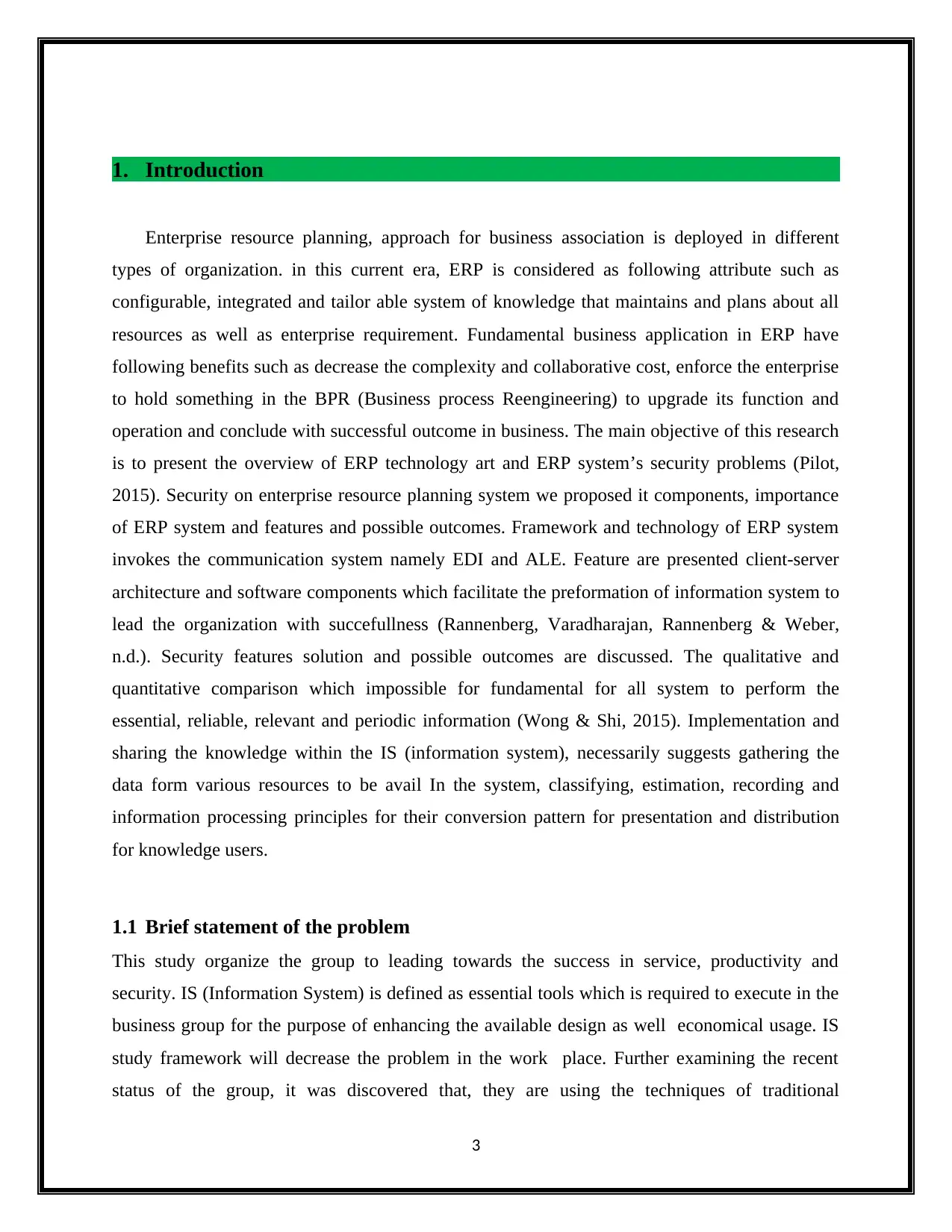
1. Introduction
Enterprise resource planning, approach for business association is deployed in different
types of organization. in this current era, ERP is considered as following attribute such as
configurable, integrated and tailor able system of knowledge that maintains and plans about all
resources as well as enterprise requirement. Fundamental business application in ERP have
following benefits such as decrease the complexity and collaborative cost, enforce the enterprise
to hold something in the BPR (Business process Reengineering) to upgrade its function and
operation and conclude with successful outcome in business. The main objective of this research
is to present the overview of ERP technology art and ERP system’s security problems (Pilot,
2015). Security on enterprise resource planning system we proposed it components, importance
of ERP system and features and possible outcomes. Framework and technology of ERP system
invokes the communication system namely EDI and ALE. Feature are presented client-server
architecture and software components which facilitate the preformation of information system to
lead the organization with succefullness (Rannenberg, Varadharajan, Rannenberg & Weber,
n.d.). Security features solution and possible outcomes are discussed. The qualitative and
quantitative comparison which impossible for fundamental for all system to perform the
essential, reliable, relevant and periodic information (Wong & Shi, 2015). Implementation and
sharing the knowledge within the IS (information system), necessarily suggests gathering the
data form various resources to be avail In the system, classifying, estimation, recording and
information processing principles for their conversion pattern for presentation and distribution
for knowledge users.
1.1 Brief statement of the problem
This study organize the group to leading towards the success in service, productivity and
security. IS (Information System) is defined as essential tools which is required to execute in the
business group for the purpose of enhancing the available design as well economical usage. IS
study framework will decrease the problem in the work place. Further examining the recent
status of the group, it was discovered that, they are using the techniques of traditional
3
Enterprise resource planning, approach for business association is deployed in different
types of organization. in this current era, ERP is considered as following attribute such as
configurable, integrated and tailor able system of knowledge that maintains and plans about all
resources as well as enterprise requirement. Fundamental business application in ERP have
following benefits such as decrease the complexity and collaborative cost, enforce the enterprise
to hold something in the BPR (Business process Reengineering) to upgrade its function and
operation and conclude with successful outcome in business. The main objective of this research
is to present the overview of ERP technology art and ERP system’s security problems (Pilot,
2015). Security on enterprise resource planning system we proposed it components, importance
of ERP system and features and possible outcomes. Framework and technology of ERP system
invokes the communication system namely EDI and ALE. Feature are presented client-server
architecture and software components which facilitate the preformation of information system to
lead the organization with succefullness (Rannenberg, Varadharajan, Rannenberg & Weber,
n.d.). Security features solution and possible outcomes are discussed. The qualitative and
quantitative comparison which impossible for fundamental for all system to perform the
essential, reliable, relevant and periodic information (Wong & Shi, 2015). Implementation and
sharing the knowledge within the IS (information system), necessarily suggests gathering the
data form various resources to be avail In the system, classifying, estimation, recording and
information processing principles for their conversion pattern for presentation and distribution
for knowledge users.
1.1 Brief statement of the problem
This study organize the group to leading towards the success in service, productivity and
security. IS (Information System) is defined as essential tools which is required to execute in the
business group for the purpose of enhancing the available design as well economical usage. IS
study framework will decrease the problem in the work place. Further examining the recent
status of the group, it was discovered that, they are using the techniques of traditional
3
Paraphrase This Document
Need a fresh take? Get an instant paraphrase of this document with our AI Paraphraser
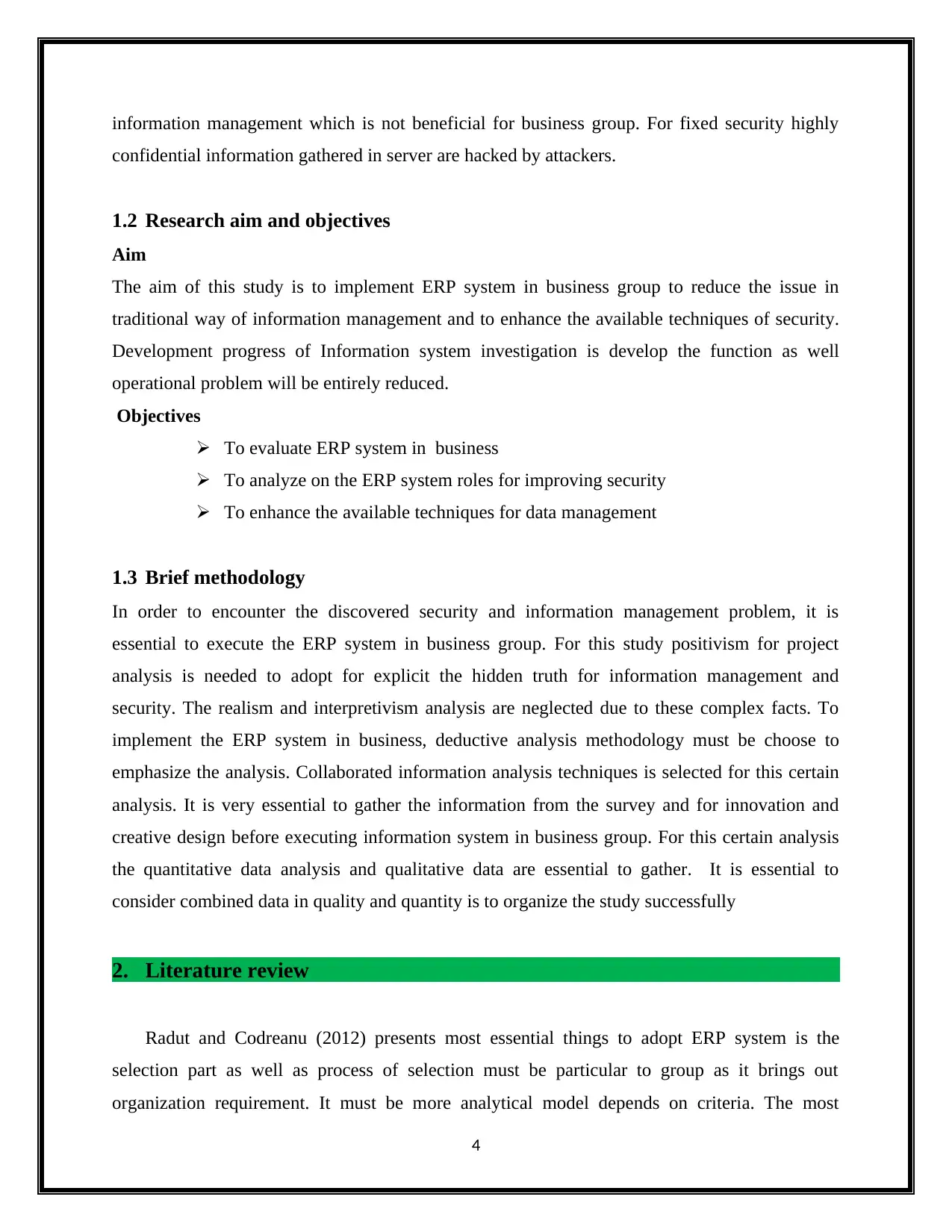
information management which is not beneficial for business group. For fixed security highly
confidential information gathered in server are hacked by attackers.
1.2 Research aim and objectives
Aim
The aim of this study is to implement ERP system in business group to reduce the issue in
traditional way of information management and to enhance the available techniques of security.
Development progress of Information system investigation is develop the function as well
operational problem will be entirely reduced.
Objectives
To evaluate ERP system in business
To analyze on the ERP system roles for improving security
To enhance the available techniques for data management
1.3 Brief methodology
In order to encounter the discovered security and information management problem, it is
essential to execute the ERP system in business group. For this study positivism for project
analysis is needed to adopt for explicit the hidden truth for information management and
security. The realism and interpretivism analysis are neglected due to these complex facts. To
implement the ERP system in business, deductive analysis methodology must be choose to
emphasize the analysis. Collaborated information analysis techniques is selected for this certain
analysis. It is very essential to gather the information from the survey and for innovation and
creative design before executing information system in business group. For this certain analysis
the quantitative data analysis and qualitative data are essential to gather. It is essential to
consider combined data in quality and quantity is to organize the study successfully
2. Literature review
Radut and Codreanu (2012) presents most essential things to adopt ERP system is the
selection part as well as process of selection must be particular to group as it brings out
organization requirement. It must be more analytical model depends on criteria. The most
4
confidential information gathered in server are hacked by attackers.
1.2 Research aim and objectives
Aim
The aim of this study is to implement ERP system in business group to reduce the issue in
traditional way of information management and to enhance the available techniques of security.
Development progress of Information system investigation is develop the function as well
operational problem will be entirely reduced.
Objectives
To evaluate ERP system in business
To analyze on the ERP system roles for improving security
To enhance the available techniques for data management
1.3 Brief methodology
In order to encounter the discovered security and information management problem, it is
essential to execute the ERP system in business group. For this study positivism for project
analysis is needed to adopt for explicit the hidden truth for information management and
security. The realism and interpretivism analysis are neglected due to these complex facts. To
implement the ERP system in business, deductive analysis methodology must be choose to
emphasize the analysis. Collaborated information analysis techniques is selected for this certain
analysis. It is very essential to gather the information from the survey and for innovation and
creative design before executing information system in business group. For this certain analysis
the quantitative data analysis and qualitative data are essential to gather. It is essential to
consider combined data in quality and quantity is to organize the study successfully
2. Literature review
Radut and Codreanu (2012) presents most essential things to adopt ERP system is the
selection part as well as process of selection must be particular to group as it brings out
organization requirement. It must be more analytical model depends on criteria. The most
4
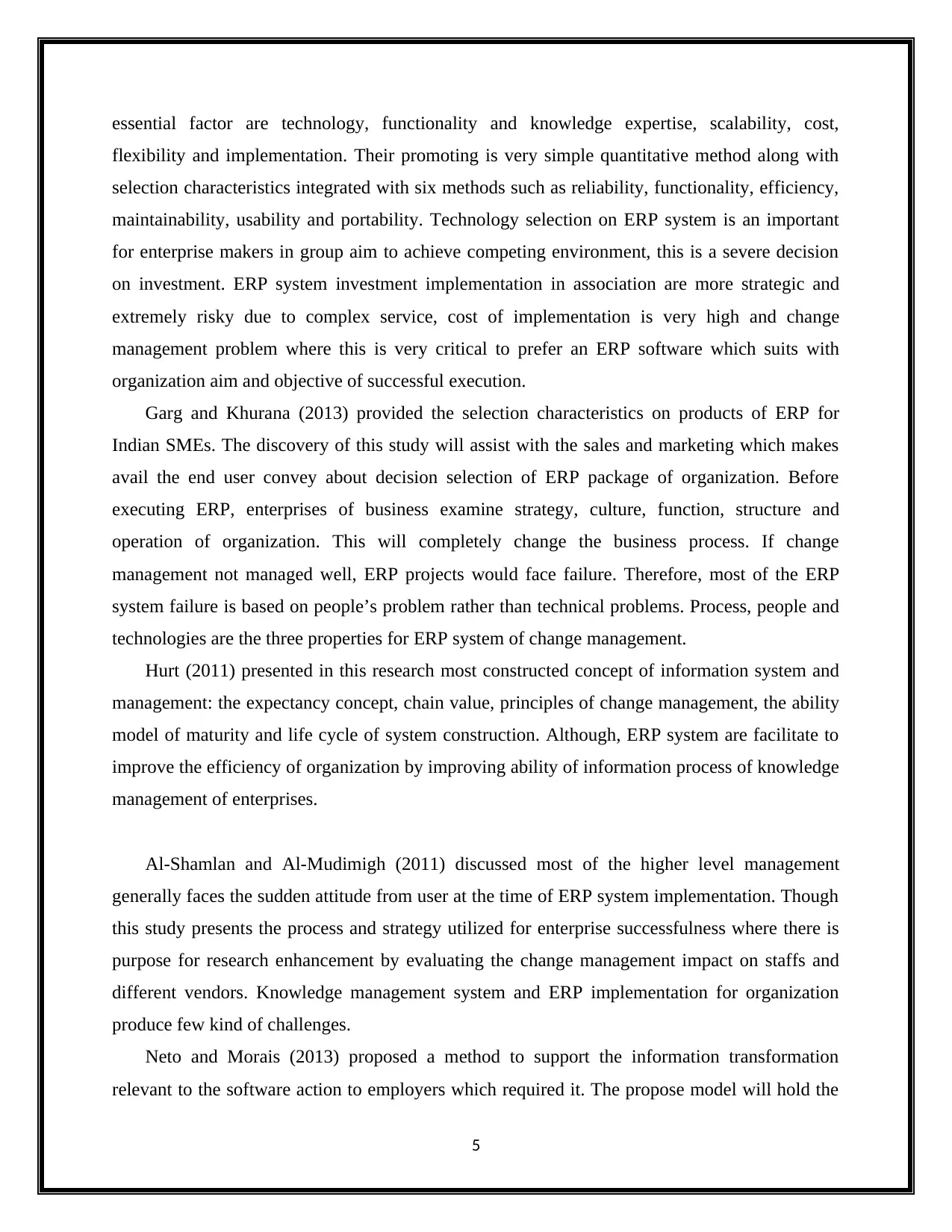
essential factor are technology, functionality and knowledge expertise, scalability, cost,
flexibility and implementation. Their promoting is very simple quantitative method along with
selection characteristics integrated with six methods such as reliability, functionality, efficiency,
maintainability, usability and portability. Technology selection on ERP system is an important
for enterprise makers in group aim to achieve competing environment, this is a severe decision
on investment. ERP system investment implementation in association are more strategic and
extremely risky due to complex service, cost of implementation is very high and change
management problem where this is very critical to prefer an ERP software which suits with
organization aim and objective of successful execution.
Garg and Khurana (2013) provided the selection characteristics on products of ERP for
Indian SMEs. The discovery of this study will assist with the sales and marketing which makes
avail the end user convey about decision selection of ERP package of organization. Before
executing ERP, enterprises of business examine strategy, culture, function, structure and
operation of organization. This will completely change the business process. If change
management not managed well, ERP projects would face failure. Therefore, most of the ERP
system failure is based on people’s problem rather than technical problems. Process, people and
technologies are the three properties for ERP system of change management.
Hurt (2011) presented in this research most constructed concept of information system and
management: the expectancy concept, chain value, principles of change management, the ability
model of maturity and life cycle of system construction. Although, ERP system are facilitate to
improve the efficiency of organization by improving ability of information process of knowledge
management of enterprises.
Al-Shamlan and Al-Mudimigh (2011) discussed most of the higher level management
generally faces the sudden attitude from user at the time of ERP system implementation. Though
this study presents the process and strategy utilized for enterprise successfulness where there is
purpose for research enhancement by evaluating the change management impact on staffs and
different vendors. Knowledge management system and ERP implementation for organization
produce few kind of challenges.
Neto and Morais (2013) proposed a method to support the information transformation
relevant to the software action to employers which required it. The propose model will hold the
5
flexibility and implementation. Their promoting is very simple quantitative method along with
selection characteristics integrated with six methods such as reliability, functionality, efficiency,
maintainability, usability and portability. Technology selection on ERP system is an important
for enterprise makers in group aim to achieve competing environment, this is a severe decision
on investment. ERP system investment implementation in association are more strategic and
extremely risky due to complex service, cost of implementation is very high and change
management problem where this is very critical to prefer an ERP software which suits with
organization aim and objective of successful execution.
Garg and Khurana (2013) provided the selection characteristics on products of ERP for
Indian SMEs. The discovery of this study will assist with the sales and marketing which makes
avail the end user convey about decision selection of ERP package of organization. Before
executing ERP, enterprises of business examine strategy, culture, function, structure and
operation of organization. This will completely change the business process. If change
management not managed well, ERP projects would face failure. Therefore, most of the ERP
system failure is based on people’s problem rather than technical problems. Process, people and
technologies are the three properties for ERP system of change management.
Hurt (2011) presented in this research most constructed concept of information system and
management: the expectancy concept, chain value, principles of change management, the ability
model of maturity and life cycle of system construction. Although, ERP system are facilitate to
improve the efficiency of organization by improving ability of information process of knowledge
management of enterprises.
Al-Shamlan and Al-Mudimigh (2011) discussed most of the higher level management
generally faces the sudden attitude from user at the time of ERP system implementation. Though
this study presents the process and strategy utilized for enterprise successfulness where there is
purpose for research enhancement by evaluating the change management impact on staffs and
different vendors. Knowledge management system and ERP implementation for organization
produce few kind of challenges.
Neto and Morais (2013) proposed a method to support the information transformation
relevant to the software action to employers which required it. The propose model will hold the
5
⊘ This is a preview!⊘
Do you want full access?
Subscribe today to unlock all pages.

Trusted by 1+ million students worldwide
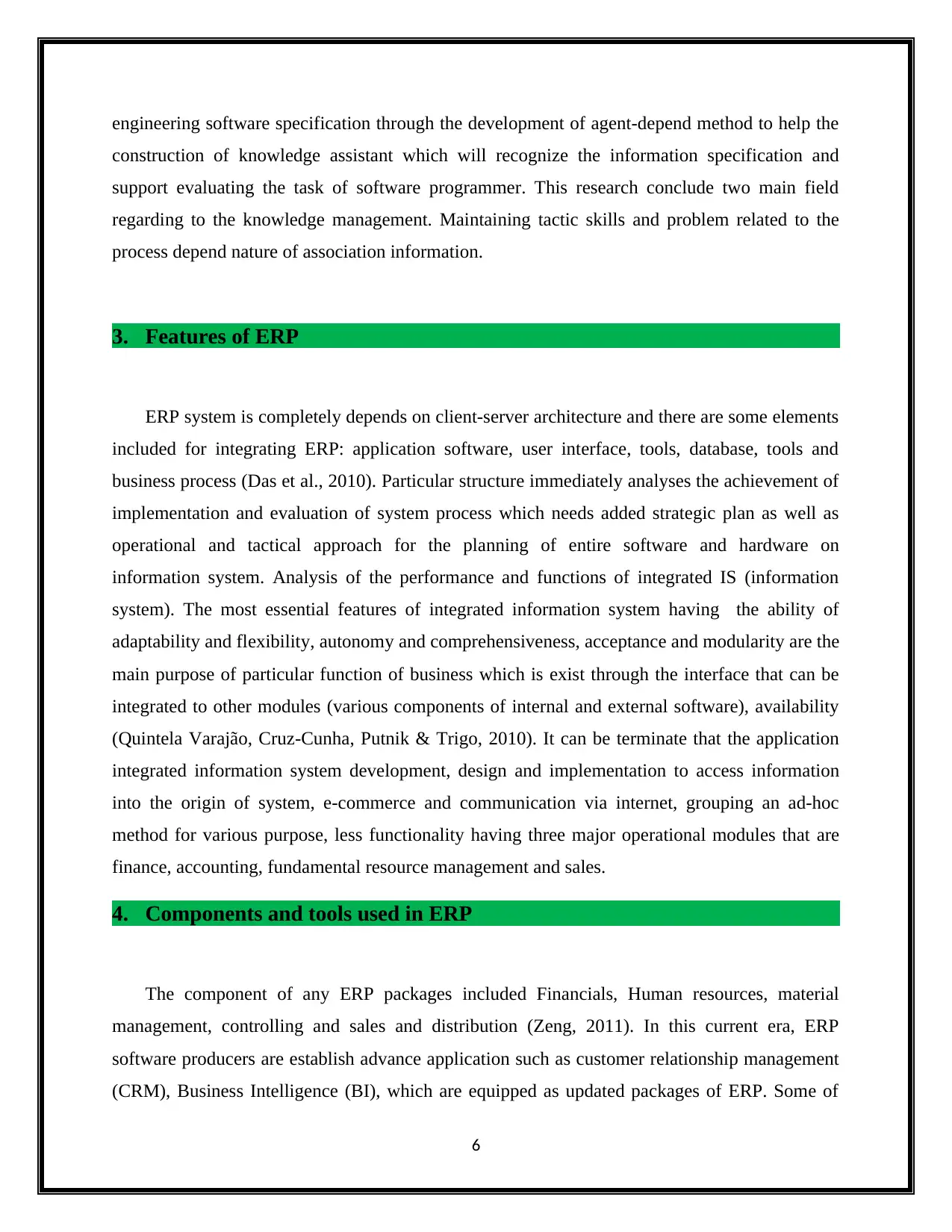
engineering software specification through the development of agent-depend method to help the
construction of knowledge assistant which will recognize the information specification and
support evaluating the task of software programmer. This research conclude two main field
regarding to the knowledge management. Maintaining tactic skills and problem related to the
process depend nature of association information.
3. Features of ERP
ERP system is completely depends on client-server architecture and there are some elements
included for integrating ERP: application software, user interface, tools, database, tools and
business process (Das et al., 2010). Particular structure immediately analyses the achievement of
implementation and evaluation of system process which needs added strategic plan as well as
operational and tactical approach for the planning of entire software and hardware on
information system. Analysis of the performance and functions of integrated IS (information
system). The most essential features of integrated information system having the ability of
adaptability and flexibility, autonomy and comprehensiveness, acceptance and modularity are the
main purpose of particular function of business which is exist through the interface that can be
integrated to other modules (various components of internal and external software), availability
(Quintela Varajão, Cruz-Cunha, Putnik & Trigo, 2010). It can be terminate that the application
integrated information system development, design and implementation to access information
into the origin of system, e-commerce and communication via internet, grouping an ad-hoc
method for various purpose, less functionality having three major operational modules that are
finance, accounting, fundamental resource management and sales.
4. Components and tools used in ERP
The component of any ERP packages included Financials, Human resources, material
management, controlling and sales and distribution (Zeng, 2011). In this current era, ERP
software producers are establish advance application such as customer relationship management
(CRM), Business Intelligence (BI), which are equipped as updated packages of ERP. Some of
6
construction of knowledge assistant which will recognize the information specification and
support evaluating the task of software programmer. This research conclude two main field
regarding to the knowledge management. Maintaining tactic skills and problem related to the
process depend nature of association information.
3. Features of ERP
ERP system is completely depends on client-server architecture and there are some elements
included for integrating ERP: application software, user interface, tools, database, tools and
business process (Das et al., 2010). Particular structure immediately analyses the achievement of
implementation and evaluation of system process which needs added strategic plan as well as
operational and tactical approach for the planning of entire software and hardware on
information system. Analysis of the performance and functions of integrated IS (information
system). The most essential features of integrated information system having the ability of
adaptability and flexibility, autonomy and comprehensiveness, acceptance and modularity are the
main purpose of particular function of business which is exist through the interface that can be
integrated to other modules (various components of internal and external software), availability
(Quintela Varajão, Cruz-Cunha, Putnik & Trigo, 2010). It can be terminate that the application
integrated information system development, design and implementation to access information
into the origin of system, e-commerce and communication via internet, grouping an ad-hoc
method for various purpose, less functionality having three major operational modules that are
finance, accounting, fundamental resource management and sales.
4. Components and tools used in ERP
The component of any ERP packages included Financials, Human resources, material
management, controlling and sales and distribution (Zeng, 2011). In this current era, ERP
software producers are establish advance application such as customer relationship management
(CRM), Business Intelligence (BI), which are equipped as updated packages of ERP. Some of
6
Paraphrase This Document
Need a fresh take? Get an instant paraphrase of this document with our AI Paraphraser
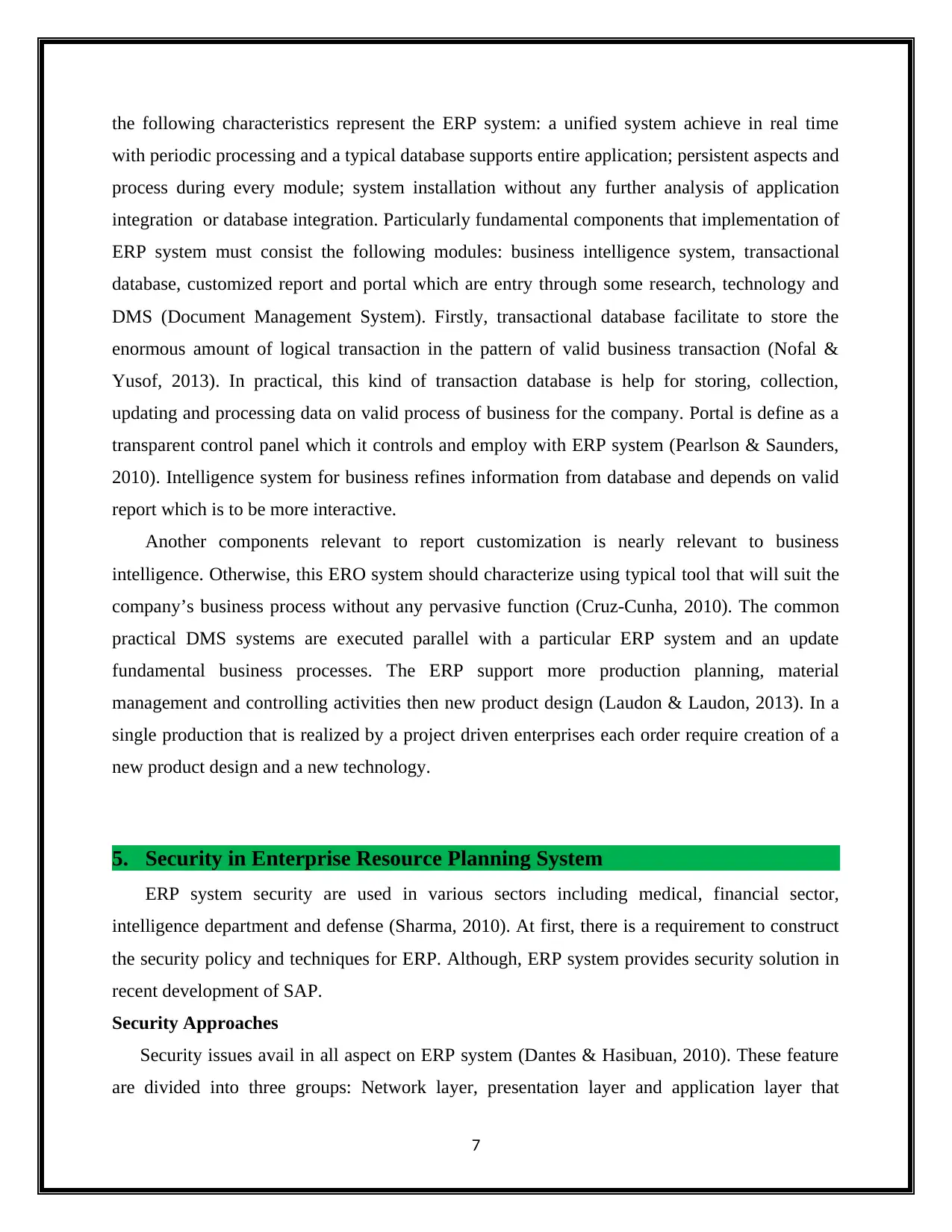
the following characteristics represent the ERP system: a unified system achieve in real time
with periodic processing and a typical database supports entire application; persistent aspects and
process during every module; system installation without any further analysis of application
integration or database integration. Particularly fundamental components that implementation of
ERP system must consist the following modules: business intelligence system, transactional
database, customized report and portal which are entry through some research, technology and
DMS (Document Management System). Firstly, transactional database facilitate to store the
enormous amount of logical transaction in the pattern of valid business transaction (Nofal &
Yusof, 2013). In practical, this kind of transaction database is help for storing, collection,
updating and processing data on valid process of business for the company. Portal is define as a
transparent control panel which it controls and employ with ERP system (Pearlson & Saunders,
2010). Intelligence system for business refines information from database and depends on valid
report which is to be more interactive.
Another components relevant to report customization is nearly relevant to business
intelligence. Otherwise, this ERO system should characterize using typical tool that will suit the
company’s business process without any pervasive function (Cruz-Cunha, 2010). The common
practical DMS systems are executed parallel with a particular ERP system and an update
fundamental business processes. The ERP support more production planning, material
management and controlling activities then new product design (Laudon & Laudon, 2013). In a
single production that is realized by a project driven enterprises each order require creation of a
new product design and a new technology.
5. Security in Enterprise Resource Planning System
ERP system security are used in various sectors including medical, financial sector,
intelligence department and defense (Sharma, 2010). At first, there is a requirement to construct
the security policy and techniques for ERP. Although, ERP system provides security solution in
recent development of SAP.
Security Approaches
Security issues avail in all aspect on ERP system (Dantes & Hasibuan, 2010). These feature
are divided into three groups: Network layer, presentation layer and application layer that
7
with periodic processing and a typical database supports entire application; persistent aspects and
process during every module; system installation without any further analysis of application
integration or database integration. Particularly fundamental components that implementation of
ERP system must consist the following modules: business intelligence system, transactional
database, customized report and portal which are entry through some research, technology and
DMS (Document Management System). Firstly, transactional database facilitate to store the
enormous amount of logical transaction in the pattern of valid business transaction (Nofal &
Yusof, 2013). In practical, this kind of transaction database is help for storing, collection,
updating and processing data on valid process of business for the company. Portal is define as a
transparent control panel which it controls and employ with ERP system (Pearlson & Saunders,
2010). Intelligence system for business refines information from database and depends on valid
report which is to be more interactive.
Another components relevant to report customization is nearly relevant to business
intelligence. Otherwise, this ERO system should characterize using typical tool that will suit the
company’s business process without any pervasive function (Cruz-Cunha, 2010). The common
practical DMS systems are executed parallel with a particular ERP system and an update
fundamental business processes. The ERP support more production planning, material
management and controlling activities then new product design (Laudon & Laudon, 2013). In a
single production that is realized by a project driven enterprises each order require creation of a
new product design and a new technology.
5. Security in Enterprise Resource Planning System
ERP system security are used in various sectors including medical, financial sector,
intelligence department and defense (Sharma, 2010). At first, there is a requirement to construct
the security policy and techniques for ERP. Although, ERP system provides security solution in
recent development of SAP.
Security Approaches
Security issues avail in all aspect on ERP system (Dantes & Hasibuan, 2010). These feature
are divided into three groups: Network layer, presentation layer and application layer that
7
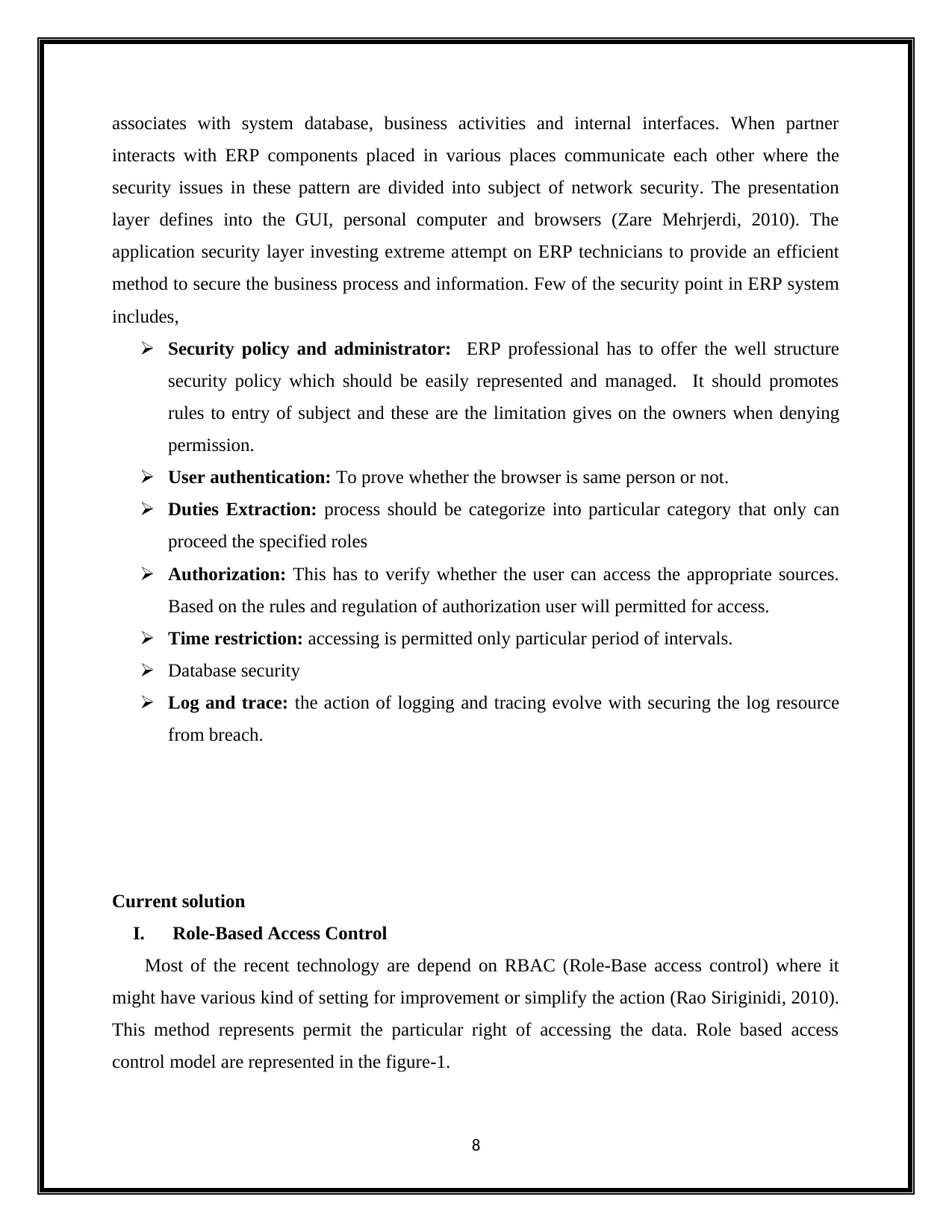
associates with system database, business activities and internal interfaces. When partner
interacts with ERP components placed in various places communicate each other where the
security issues in these pattern are divided into subject of network security. The presentation
layer defines into the GUI, personal computer and browsers (Zare Mehrjerdi, 2010). The
application security layer investing extreme attempt on ERP technicians to provide an efficient
method to secure the business process and information. Few of the security point in ERP system
includes,
Security policy and administrator: ERP professional has to offer the well structure
security policy which should be easily represented and managed. It should promotes
rules to entry of subject and these are the limitation gives on the owners when denying
permission.
User authentication: To prove whether the browser is same person or not.
Duties Extraction: process should be categorize into particular category that only can
proceed the specified roles
Authorization: This has to verify whether the user can access the appropriate sources.
Based on the rules and regulation of authorization user will permitted for access.
Time restriction: accessing is permitted only particular period of intervals.
Database security
Log and trace: the action of logging and tracing evolve with securing the log resource
from breach.
Current solution
I. Role-Based Access Control
Most of the recent technology are depend on RBAC (Role-Base access control) where it
might have various kind of setting for improvement or simplify the action (Rao Siriginidi, 2010).
This method represents permit the particular right of accessing the data. Role based access
control model are represented in the figure-1.
8
interacts with ERP components placed in various places communicate each other where the
security issues in these pattern are divided into subject of network security. The presentation
layer defines into the GUI, personal computer and browsers (Zare Mehrjerdi, 2010). The
application security layer investing extreme attempt on ERP technicians to provide an efficient
method to secure the business process and information. Few of the security point in ERP system
includes,
Security policy and administrator: ERP professional has to offer the well structure
security policy which should be easily represented and managed. It should promotes
rules to entry of subject and these are the limitation gives on the owners when denying
permission.
User authentication: To prove whether the browser is same person or not.
Duties Extraction: process should be categorize into particular category that only can
proceed the specified roles
Authorization: This has to verify whether the user can access the appropriate sources.
Based on the rules and regulation of authorization user will permitted for access.
Time restriction: accessing is permitted only particular period of intervals.
Database security
Log and trace: the action of logging and tracing evolve with securing the log resource
from breach.
Current solution
I. Role-Based Access Control
Most of the recent technology are depend on RBAC (Role-Base access control) where it
might have various kind of setting for improvement or simplify the action (Rao Siriginidi, 2010).
This method represents permit the particular right of accessing the data. Role based access
control model are represented in the figure-1.
8
⊘ This is a preview!⊘
Do you want full access?
Subscribe today to unlock all pages.

Trusted by 1+ million students worldwide
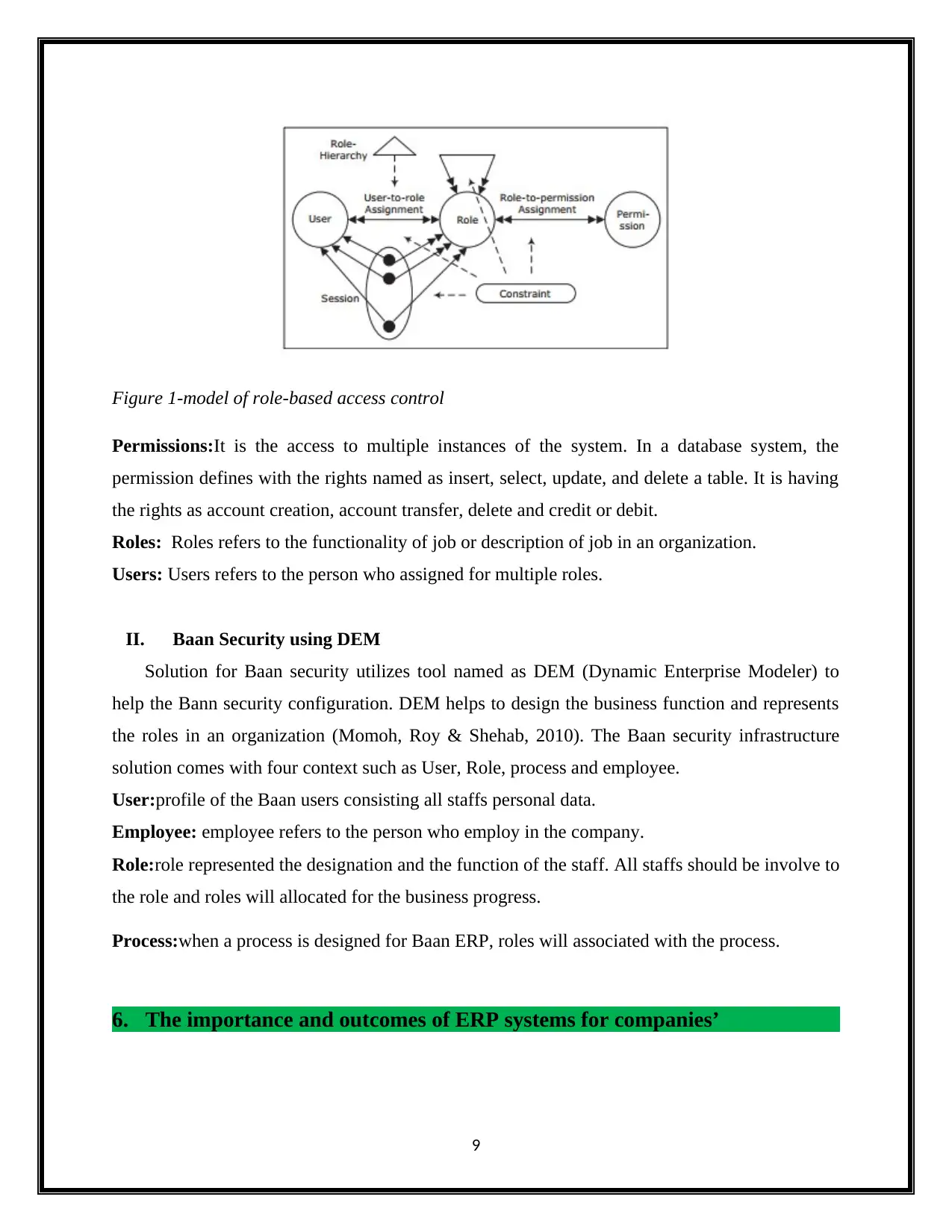
Figure 1-model of role-based access control
Permissions:It is the access to multiple instances of the system. In a database system, the
permission defines with the rights named as insert, select, update, and delete a table. It is having
the rights as account creation, account transfer, delete and credit or debit.
Roles: Roles refers to the functionality of job or description of job in an organization.
Users: Users refers to the person who assigned for multiple roles.
II. Baan Security using DEM
Solution for Baan security utilizes tool named as DEM (Dynamic Enterprise Modeler) to
help the Bann security configuration. DEM helps to design the business function and represents
the roles in an organization (Momoh, Roy & Shehab, 2010). The Baan security infrastructure
solution comes with four context such as User, Role, process and employee.
User:profile of the Baan users consisting all staffs personal data.
Employee: employee refers to the person who employ in the company.
Role:role represented the designation and the function of the staff. All staffs should be involve to
the role and roles will allocated for the business progress.
Process:when a process is designed for Baan ERP, roles will associated with the process.
6. The importance and outcomes of ERP systems for companies’
9
Permissions:It is the access to multiple instances of the system. In a database system, the
permission defines with the rights named as insert, select, update, and delete a table. It is having
the rights as account creation, account transfer, delete and credit or debit.
Roles: Roles refers to the functionality of job or description of job in an organization.
Users: Users refers to the person who assigned for multiple roles.
II. Baan Security using DEM
Solution for Baan security utilizes tool named as DEM (Dynamic Enterprise Modeler) to
help the Bann security configuration. DEM helps to design the business function and represents
the roles in an organization (Momoh, Roy & Shehab, 2010). The Baan security infrastructure
solution comes with four context such as User, Role, process and employee.
User:profile of the Baan users consisting all staffs personal data.
Employee: employee refers to the person who employ in the company.
Role:role represented the designation and the function of the staff. All staffs should be involve to
the role and roles will allocated for the business progress.
Process:when a process is designed for Baan ERP, roles will associated with the process.
6. The importance and outcomes of ERP systems for companies’
9
Paraphrase This Document
Need a fresh take? Get an instant paraphrase of this document with our AI Paraphraser
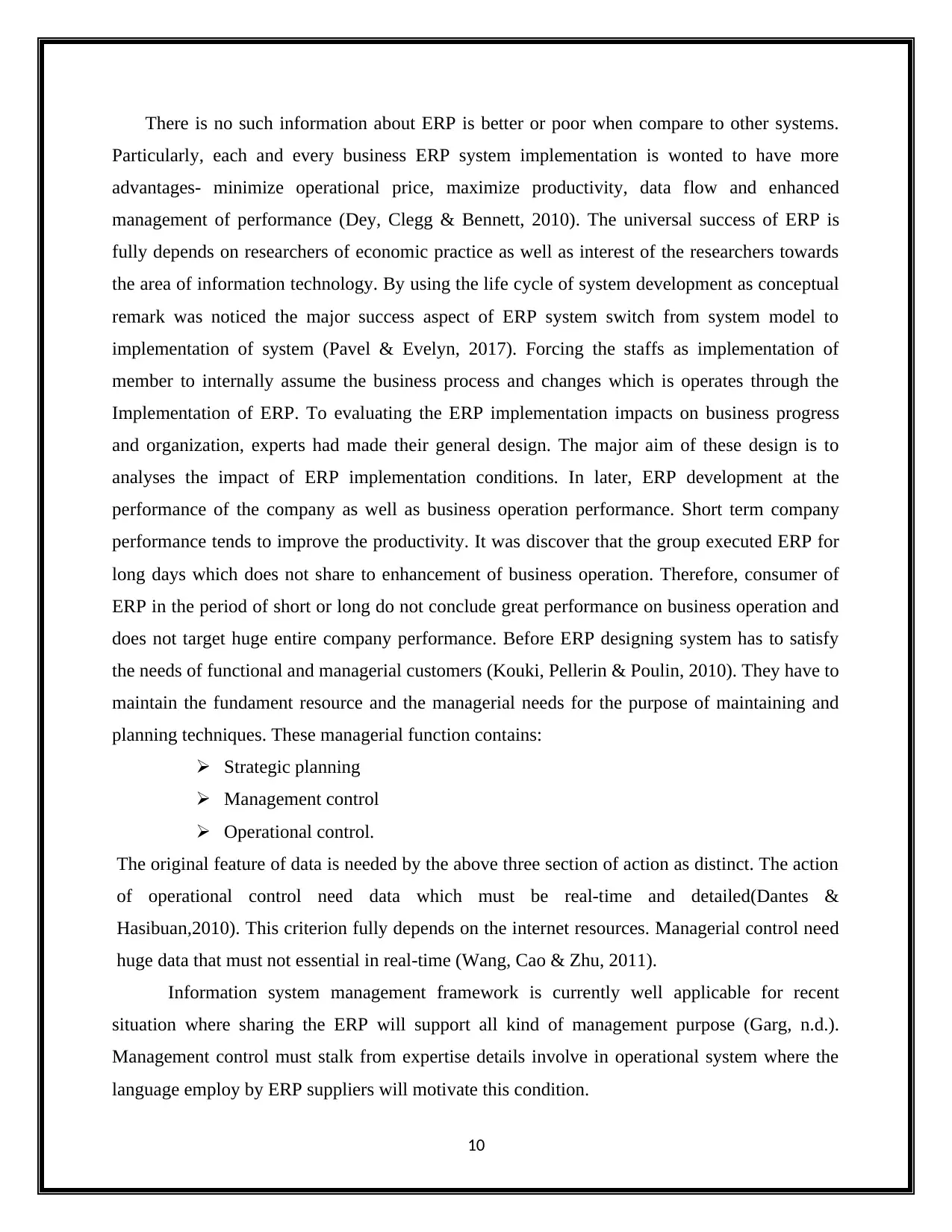
There is no such information about ERP is better or poor when compare to other systems.
Particularly, each and every business ERP system implementation is wonted to have more
advantages- minimize operational price, maximize productivity, data flow and enhanced
management of performance (Dey, Clegg & Bennett, 2010). The universal success of ERP is
fully depends on researchers of economic practice as well as interest of the researchers towards
the area of information technology. By using the life cycle of system development as conceptual
remark was noticed the major success aspect of ERP system switch from system model to
implementation of system (Pavel & Evelyn, 2017). Forcing the staffs as implementation of
member to internally assume the business process and changes which is operates through the
Implementation of ERP. To evaluating the ERP implementation impacts on business progress
and organization, experts had made their general design. The major aim of these design is to
analyses the impact of ERP implementation conditions. In later, ERP development at the
performance of the company as well as business operation performance. Short term company
performance tends to improve the productivity. It was discover that the group executed ERP for
long days which does not share to enhancement of business operation. Therefore, consumer of
ERP in the period of short or long do not conclude great performance on business operation and
does not target huge entire company performance. Before ERP designing system has to satisfy
the needs of functional and managerial customers (Kouki, Pellerin & Poulin, 2010). They have to
maintain the fundament resource and the managerial needs for the purpose of maintaining and
planning techniques. These managerial function contains:
Strategic planning
Management control
Operational control.
The original feature of data is needed by the above three section of action as distinct. The action
of operational control need data which must be real-time and detailed(Dantes &
Hasibuan,2010). This criterion fully depends on the internet resources. Managerial control need
huge data that must not essential in real-time (Wang, Cao & Zhu, 2011).
Information system management framework is currently well applicable for recent
situation where sharing the ERP will support all kind of management purpose (Garg, n.d.).
Management control must stalk from expertise details involve in operational system where the
language employ by ERP suppliers will motivate this condition.
10
Particularly, each and every business ERP system implementation is wonted to have more
advantages- minimize operational price, maximize productivity, data flow and enhanced
management of performance (Dey, Clegg & Bennett, 2010). The universal success of ERP is
fully depends on researchers of economic practice as well as interest of the researchers towards
the area of information technology. By using the life cycle of system development as conceptual
remark was noticed the major success aspect of ERP system switch from system model to
implementation of system (Pavel & Evelyn, 2017). Forcing the staffs as implementation of
member to internally assume the business process and changes which is operates through the
Implementation of ERP. To evaluating the ERP implementation impacts on business progress
and organization, experts had made their general design. The major aim of these design is to
analyses the impact of ERP implementation conditions. In later, ERP development at the
performance of the company as well as business operation performance. Short term company
performance tends to improve the productivity. It was discover that the group executed ERP for
long days which does not share to enhancement of business operation. Therefore, consumer of
ERP in the period of short or long do not conclude great performance on business operation and
does not target huge entire company performance. Before ERP designing system has to satisfy
the needs of functional and managerial customers (Kouki, Pellerin & Poulin, 2010). They have to
maintain the fundament resource and the managerial needs for the purpose of maintaining and
planning techniques. These managerial function contains:
Strategic planning
Management control
Operational control.
The original feature of data is needed by the above three section of action as distinct. The action
of operational control need data which must be real-time and detailed(Dantes &
Hasibuan,2010). This criterion fully depends on the internet resources. Managerial control need
huge data that must not essential in real-time (Wang, Cao & Zhu, 2011).
Information system management framework is currently well applicable for recent
situation where sharing the ERP will support all kind of management purpose (Garg, n.d.).
Management control must stalk from expertise details involve in operational system where the
language employ by ERP suppliers will motivate this condition.
10
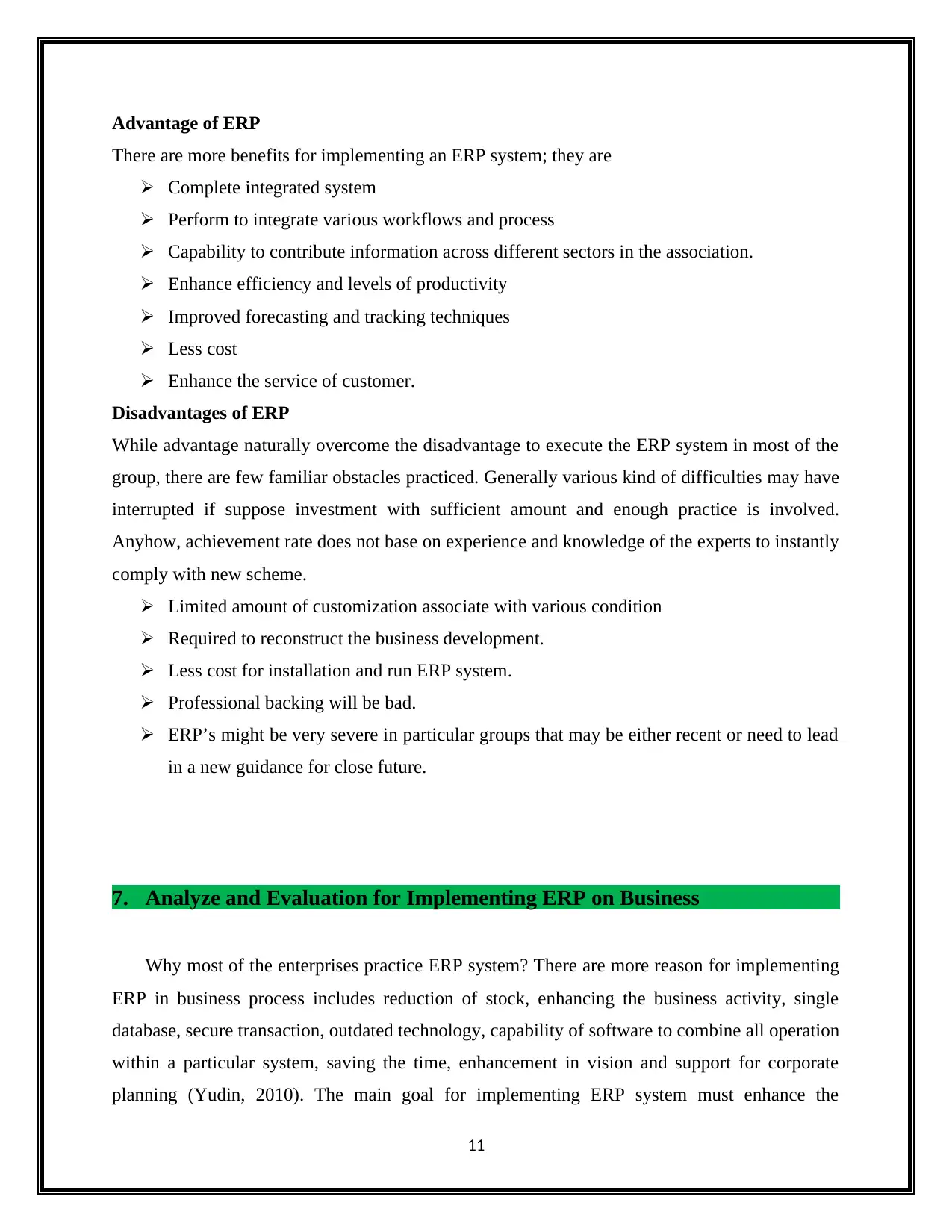
Advantage of ERP
There are more benefits for implementing an ERP system; they are
Complete integrated system
Perform to integrate various workflows and process
Capability to contribute information across different sectors in the association.
Enhance efficiency and levels of productivity
Improved forecasting and tracking techniques
Less cost
Enhance the service of customer.
Disadvantages of ERP
While advantage naturally overcome the disadvantage to execute the ERP system in most of the
group, there are few familiar obstacles practiced. Generally various kind of difficulties may have
interrupted if suppose investment with sufficient amount and enough practice is involved.
Anyhow, achievement rate does not base on experience and knowledge of the experts to instantly
comply with new scheme.
Limited amount of customization associate with various condition
Required to reconstruct the business development.
Less cost for installation and run ERP system.
Professional backing will be bad.
ERP’s might be very severe in particular groups that may be either recent or need to lead
in a new guidance for close future.
7. Analyze and Evaluation for Implementing ERP on Business
Why most of the enterprises practice ERP system? There are more reason for implementing
ERP in business process includes reduction of stock, enhancing the business activity, single
database, secure transaction, outdated technology, capability of software to combine all operation
within a particular system, saving the time, enhancement in vision and support for corporate
planning (Yudin, 2010). The main goal for implementing ERP system must enhance the
11
There are more benefits for implementing an ERP system; they are
Complete integrated system
Perform to integrate various workflows and process
Capability to contribute information across different sectors in the association.
Enhance efficiency and levels of productivity
Improved forecasting and tracking techniques
Less cost
Enhance the service of customer.
Disadvantages of ERP
While advantage naturally overcome the disadvantage to execute the ERP system in most of the
group, there are few familiar obstacles practiced. Generally various kind of difficulties may have
interrupted if suppose investment with sufficient amount and enough practice is involved.
Anyhow, achievement rate does not base on experience and knowledge of the experts to instantly
comply with new scheme.
Limited amount of customization associate with various condition
Required to reconstruct the business development.
Less cost for installation and run ERP system.
Professional backing will be bad.
ERP’s might be very severe in particular groups that may be either recent or need to lead
in a new guidance for close future.
7. Analyze and Evaluation for Implementing ERP on Business
Why most of the enterprises practice ERP system? There are more reason for implementing
ERP in business process includes reduction of stock, enhancing the business activity, single
database, secure transaction, outdated technology, capability of software to combine all operation
within a particular system, saving the time, enhancement in vision and support for corporate
planning (Yudin, 2010). The main goal for implementing ERP system must enhance the
11
⊘ This is a preview!⊘
Do you want full access?
Subscribe today to unlock all pages.

Trusted by 1+ million students worldwide
1 out of 18
Related Documents
Your All-in-One AI-Powered Toolkit for Academic Success.
+13062052269
info@desklib.com
Available 24*7 on WhatsApp / Email
![[object Object]](/_next/static/media/star-bottom.7253800d.svg)
Unlock your academic potential
Copyright © 2020–2025 A2Z Services. All Rights Reserved. Developed and managed by ZUCOL.





